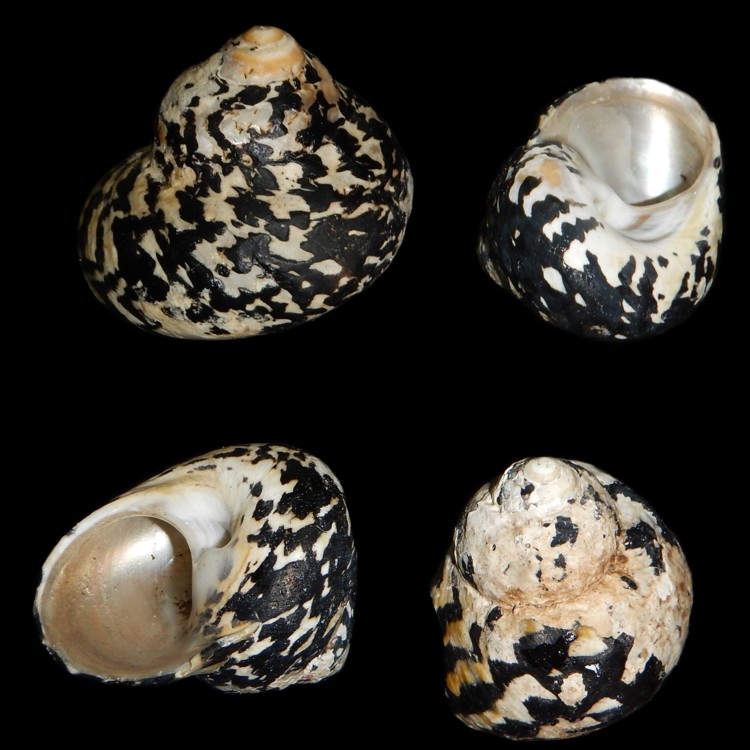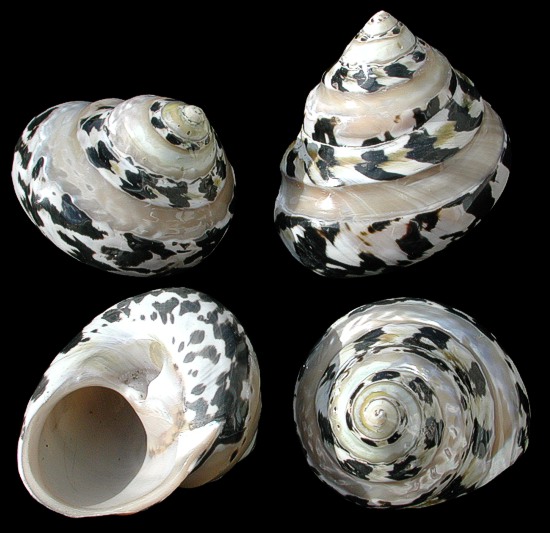Cittarium Picas

MAGPIE SHELL
Cittarium Pica, common name the West Indian top shell or magpie shell
Magpies are species of large edible sea snails, a marine gastropod mollusk in the family Tegulidae. This species has a large black and white shell.
In some Spanish-speaking parts of the Caribbean, when used as a food source Cittarium pica is known as bulgao, or simply as caracoles (snails, in Spanish). In Venezuela it is called quigua; in Cuba it is called cigua.
(REF:Cervigón, F. (1993). "Gastropods". In Carpenter, K.E. )(REF:Toller, W. (2003). "U.S.V.I. Animal Fact Sheet #15 Whelk" )
Cittarium pica is within the clade Vetigastropoda. The vetigastropods are considered to be among the most primitive living neo-gastropods, and are widely distributed in all oceans of the world. It is also part of the superfamily Trochoidea, presenting nacre as the inner shell layer, and its subordinated family Tegulidae.
(REF: Robertson, R. (2003). "The edible West Indian "whelk" Cittarium pica (Gastropoda: Trochidae): Natural history with new observations")
The shell of this species can grow to 5 1/2 inches maximum dimension. It is very thick and heavy, having an outline that is between trochiform and turbiniform in shape, with rounded shoulders and a somewhat low conical form.
(REF: Carpenter, K.E. (ed.).The living marine resources of the Western Central Atlantic. Volume 1: Introduction, molluscs, crustaceans, hagfishes, sharks, batoid fishes, and chimaeras.)(REF: Robertson, R. (2003). "The edible West Indian "whelk" Cittarium pica (Gastropoda: Trochidae): Natural history with new observations")
The spire is conoidal. It contains about six convex whorls. The large body whorl (A whorl is a single, complete 360° revolution or turn in the spiral or whorled growth of a mollusk shell) (Body whorl is the most recently formed whorl of a spiral shell, in which most of the body of the animal is found) is depressed-globose. The outer lip is simple. The lip is edged inside by black, or black and white. The columella is arcuate, produced above in a heavy porcellanous callous deposit, half-surrounding the umbilicus and deeply notched in the middle.
The shell of Cittarium pica presents a rather wide umbilicus(The umbilicus of a shell is the axially aligned, hollow cone-shaped space within the whorls of a coiled mollusk shell. The term umbilicus is often used in descriptions of gastropod shells, i.e. it is a feature present on the ventral (or under) side of many (but not all) snail shells, including some species of sea snails, land snails, and freshwater snails.), which is deep and devoid of sculpture, but spirally bicostate inside. The semicircular, oblique aperture is distinguishably nacreous inside as is the case in other Trochoidea, and is circular. The parietal callus is glossy and delicate, and has a node that projects towards the umbilicus. Juvenile individuals possess shells ornamented by spiral lines and strong cords, in contrast to the nearly smooth, homogeneous surface of mature specimens
The lusterless color pattern is rather distinct, overall white with black zigzag flammules on each whorl. Those spots have a tendency to become axial lines in older, larger individuals. The upper surface is often entirely black. The aperture is commonly white, with an inner iridescence because of the nacre(Nacre also known as mother of pearl, is an organic–inorganic composite material produced by some molluscs as an inner shell layer. It is also the material of which pearls are composed. It is strong, resilient, and iridescent.). Young shells, or well-preserved adults, have the spire whorls sculptured by oblique folds, cut by a few spiral sulci. The periphery and the base in the half-grown shells are spirally lirate.
(REF:Robertson, R. (2003). "The edible West Indian "whelk" Cittarium pica (Gastropoda: Trochidae): Natural history with new observations" ) (REF: Tryon (1889), Manual of Conchology XI, Academy of Natural Sciences, Philadelphia)
This species occurs rarely in the Florida Keys, and in the Caribbean coast of Mexico, Costa Rica, Panama, Colombia and Venezuela. It also occurs in the Bahamas, Cuba, the Cayman Islands, Jamaica, Haiti, the Dominican Republic, Puerto Rico, and the Lesser Antilles as far south as Barbados and Trinidad and Tobago. The species has been reintroduced to Bermuda.
(REF: Toller, W. (2003). "U.S.V.I. Animal Fact Sheet #15 Whelk) (REF: Malacolog (Version 4.1.1))
These large snails are found on or under rocks, in exposed and moderately sheltered shores, both in intertidal and shallow subtidal zones. Cittarium Picas generally do not live at great depths. Most individuals are found at the water's edge, and have little tendency to disperse. Minimum recorded depth is about 1 foot & the maximum recorded depth is roughly 23 feet.
(REF: Toller, W. (2003). "U.S.V.I. Animal Fact Sheet #15 Whelk)(REF: Robertson, R. (2003). "The edible West Indian "whelk" Cittarium pica (Gastropoda: Trochidae): Natural history with new observations")(REF: Welch, J. J. (2010). "The "Island Rule" and Deep-Sea Gastropods: Re-Examining the Evidence")
Cittarium picas are dioecious, which means each individual organism belonging to this species is distinctly male or female. The fertilisation in this species occurs externally. During the reproductive season, which normally occurs from June to November in the field, male individuals release their sperm into the water, as females simultaneously release their green colored unfertilised eggs. The encounter of those gametes produce yolky fertilised eggs, which will further develop into lecitotrophic (yolk feeding) larvae. They emerge from the egg capsules as shell-cap-bearing trochophores. These trochophore larvae do not spend much time in the plankton, because settlement occurs relatively soon, after 3 1/2 to 4 1/2 days. Individuals usually reach sexual maturity at shell lengths of 1 1/4 to 1 1/3 inches. The life span of this species is still unknown, but estimates for other top shells reach 30 years.
(REF: Robertson, R. (2003). "The edible West Indian "whelk" Cittarium pica (Gastropoda: Trochidae): Natural history with new observations")
The west Indian top shells are known to be herbivores, feeding on a large variety of algae, and sometimes on detritus(detritus is dead particulate organic material, as distinguished from dissolved organic material. Detritus typically includes the bodies or fragments of bodies of dead organisms, and fecal material.). They actively scrape the algal growths off rocks, and this tends to cause erosion over time. Feeding commonly occurs during the nocturnal period (at night), when the snails are most active.
(Robertson, R. (2003). "The edible West Indian "whelk" Cittarium pica (Gastropoda: Trochidae): Natural history with new observations")
These large sea snails are boiled and eaten in a variety of different local recipes. Because of their popularity as a food item and the problem of overfishing, in the US Virgin Islands there are territorial regulations to protect these snails: no collecting is allowed during their reproductive season, and there is a minimum harvest size regulation.
(REF: Toller, W. (2003). "U.S.V.I. Animal Fact Sheet #15 Whelk")
Scientific classification
Domain: Eukaryota
Kingdom: Animalia
Phylum: Mollusca
Class: Gastropoda
Subclass: Vetigastropoda
Order: Trochida
Super family: Trochoidea
Family: Tegulidae
Genus: Cittarium
Species: C. pica
Binomial name: Cittarium Pica
(Linnaeus, 1758)
Z0-7
One 2 to 3 inch Natural Magpie Turban Shell, shell opening is about 1 inch....... .29

Pearl Banded Arapica a highly polished Cittarium Pica exposing the mother of pearl
P1-17
One approximately 3 inch Pearl Banded Arapica......$4.25